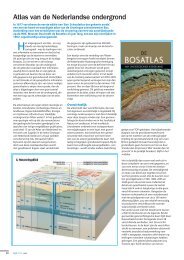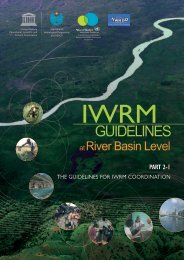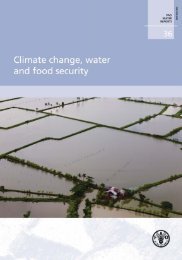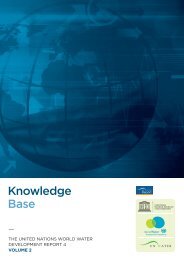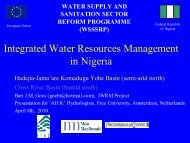Guide to Hydrological Practices, 6th edition, Volume II - Hydrology.nl
Guide to Hydrological Practices, 6th edition, Volume II - Hydrology.nl
Guide to Hydrological Practices, 6th edition, Volume II - Hydrology.nl
Create successful ePaper yourself
Turn your PDF publications into a flip-book with our unique Google optimized e-Paper software.
<strong>II</strong>.2-2GUIDE TO HYDROLOGICAL PRACTICESissuing of warnings <strong>to</strong> the public are pure publicgoods.A National <strong>Hydrological</strong> Service can provide hydrologicaldata and information at the national level ina cost-effective way. The implications of this are asfollows:(a) Products or public services, such as publicwarnings, can o<strong>nl</strong>y be provided through publicfunding, because the <strong>Hydrological</strong> Serviceconcerned cannot easily recover its costs fromthe beneficiaries;(b) To obtain or sustain funding from governmentsources for the provision of both pureand excludable public goods, it is necessary <strong>to</strong>demonstrate their value or merit <strong>to</strong> society;(c) Products or services that are excludable publicgoods can be provided on the basis of profitabilityor recovery of costs from the beneficiaries.Authority may be required for such operations.Proper accounting practices, financial transparencyand fair charges will be expected;(d) Boundaries between the management of purepublic goods and excludable public goods mayshift as a result of, for example, evolving technology,contractual arrangements and publicinformation. A <strong>Hydrological</strong> Service may beable <strong>to</strong> influence such boundaries, if it is in thenational interest;(e) When lobbying for sources of funding, managersshould review their products and services <strong>to</strong>ensure that they are in line with the mandateand pricing structure of the NHS.2.2.2 Clients of hydrologicalproducts and servicesWho are the clients of a <strong>Hydrological</strong> Service? Inprinciple, for a National <strong>Hydrological</strong> Service, theultimate client is the general public, represented byelected officials at the national, state/provincial andlocal levels. This includes the general public of thefuture, who will be the beneficiaries of hydrologicalwork that is being done <strong>to</strong>day.Governmental policies and national developmentgoals, and the information required <strong>to</strong> supportthem, influence an NHS fundamentally. For example,in many developing countries the beginningof the twenty-first century has seen a growingnational emphasis on poverty alleviation. Themanagement of a <strong>Hydrological</strong> Service shouldmoni<strong>to</strong>r governmental policies and analyse theimplications of these policies for the individualService. What products and services will the<strong>Hydrological</strong> Service need <strong>to</strong> provide in order <strong>to</strong>support national policies and goals? Do the Service’scurrent products and services contribute <strong>to</strong> this? Inother words, the management should ensure thatthe Service’s products and services have the greatestpossible value. This is best done objectively bymeans of cost-benefit, cost-effectiveness andpoverty analyses, among others. The public’s interestmay be varied, so that a <strong>Hydrological</strong> Servicemay have a variety of clients, in addition <strong>to</strong> thetraditional ones. A <strong>Hydrological</strong> Service may alsooffer private services <strong>to</strong> clients who are prepared <strong>to</strong>pay for them. The range of such clients will varyfrom country <strong>to</strong> country, depending on the natureof the national economy.The management of a particular <strong>Hydrological</strong>Service must implement frequent surveys <strong>to</strong> identifypotential clients. The management shouldcontinually moni<strong>to</strong>r trends in demand for water,national and provincial policies and developmentgoals, political manifes<strong>to</strong>s, trends and events invarious economic sec<strong>to</strong>rs, as well as internationalagreements and agreements with donor agenciesand other development partners.Client expectations of all businesses, includingthose in the public sec<strong>to</strong>r, are rising continuallyand businesses must continually seek <strong>to</strong> meet orexceed those expectations. <strong>Hydrological</strong> Servicesare no exception. To ensure the future of the Service,managers must encourage a client focus amongtheir staff. The single most important client is theperson <strong>to</strong> whom the direc<strong>to</strong>r reports, for instance,the Minister for the Environment. The future of a<strong>Hydrological</strong> Service depends on how successfullythe direc<strong>to</strong>r markets the Service <strong>to</strong> that person anddemonstrates how the Service can be useful <strong>to</strong> theclient.A marketing strategy should meet the followingaims:(a) Identify the current and potential clients of the<strong>Hydrological</strong> Service, and maintain and updatea client database;(b) Identify the products and services required bythe clients which the Service can provide;(c) Identify the most suitable mode or place ofdelivery of the product or service <strong>to</strong> the client,for example, use of the Internet <strong>to</strong> provideaccess <strong>to</strong> real-time data, fax warnings andconventional written reports with data annexeson CD-ROM;(d) Determine a pricing policy for different productsand services, and for different clients;(e) Specify the types of people involved in deliveringthe product or service;(f) Characterize the processes of product or servicedelivery according <strong>to</strong> the needs of the clients;






